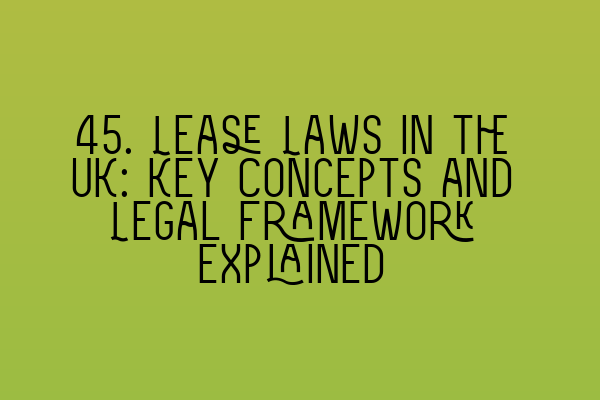Lease Laws in the UK: Key Concepts and Legal Framework Explained
Lease law in the UK is a complex and ever-evolving area of property law. Whether you’re a landlord, tenant, or property investor, having a solid understanding of lease laws is crucial to ensure compliance and protect your legal rights. In this article, we will explore the key concepts and legal framework of lease laws in the UK.
1. What is a Lease?
In simple terms, a lease is a contractual agreement between a landlord (the property owner) and a tenant (the occupier) that grants the tenant the right to use and occupy the property for a specified period of time. The lease sets out the obligations, rights, and restrictions of both parties during the tenancy.
It’s important to note that a lease is different from a tenancy agreement, which is typically used for shorter-term rental arrangements. Leases are generally longer-term agreements, often lasting for several years.
To gain a comprehensive understanding of lease laws, it’s essential to familiarize yourself with some key concepts.
2. Key Concepts in Lease Laws
a) Lessor and Lessee
The two parties involved in a lease are the lessor (landlord) and the lessee (tenant).
The lessor is the legal owner of the property and grants the lessee the right to use and occupy it in exchange for rent payments. The lessor has certain obligations, such as maintaining the property in a habitable condition and complying with relevant health and safety regulations.
The lessee, on the other hand, pays rent and must comply with the terms and conditions outlined in the lease agreement. This includes taking care of the property, paying utility bills, and using the property for its intended purpose.
b) Termination
Leases can be terminated in various ways. It’s essential for both lessors and lessees to understand the termination clauses outlined in the lease agreement.
Termination can occur at the end of the lease term when both parties mutually agree not to renew the lease. Additionally, leases can be terminated if one party breaches the terms of the agreement or if there are specific termination clauses included in the lease, such as a break clause.
Understanding the termination process is crucial to avoid disputes and ensure a smooth transition.
c) Rent Reviews
Rent reviews are often included in long-term leases to account for changes in property values and market conditions. These reviews allow the lessor to adjust the rent to reflect the current market rental value of the property.
Rent review clauses can be complex and involve specific calculations and procedures. It’s advisable to seek legal advice to ensure that the rent review process is conducted correctly and fairly.
d) Repair and Maintenance
The lease agreement usually outlines the responsibilities for repair and maintenance of the property. These obligations can vary depending on the type of lease, such as repairing obligations falling on either the lessor or lessee.
Understanding these obligations is crucial to avoid disputes and ensure that the property is kept in a satisfactory condition throughout the lease term.
e) Assignment and Subletting
The lease agreement may also include provisions related to assignment and subletting. Assignment refers to the transfer of the lease from the current lessee to a new party, whereas subletting involves the lessee renting out part or all of the property to another tenant.
These provisions often require the lessor’s consent and may be subject to certain conditions and restrictions. It’s essential to understand these provisions to protect your legal rights and avoid potential issues.
3. Legal Framework
Lease laws in the UK are primarily governed by the Landlord and Tenant Act 1985, supplemented by other legislation and case law.
The Landlord and Tenant Act 1985 sets out various rights and obligations for both landlords and tenants. It covers areas such as the payment of rent, the provision of services, the right to quiet enjoyment, and the process of terminating a lease.
In addition to the Landlord and Tenant Act 1985, other legislation, such as the Housing Act 1988, provides further regulations and protections for both parties in specific circumstances.
It’s important to have a comprehensive understanding of the legal framework to ensure compliance and protect your interests.
4. Seek Professional Advice
Lease laws can be complex, and the implications of not complying with these laws can be significant. Whether you’re a landlord or a tenant, seeking professional legal advice is crucial to ensure you fully understand your rights and obligations under the lease.
At SQE Property Law & Land Law, our team of experienced solicitors specializes in lease law and can provide expert advice tailored to your specific situation. Contact us today to discuss your lease law needs and ensure you’re on the right track.
For more information on SQE exams and preparation, check out our related articles:
